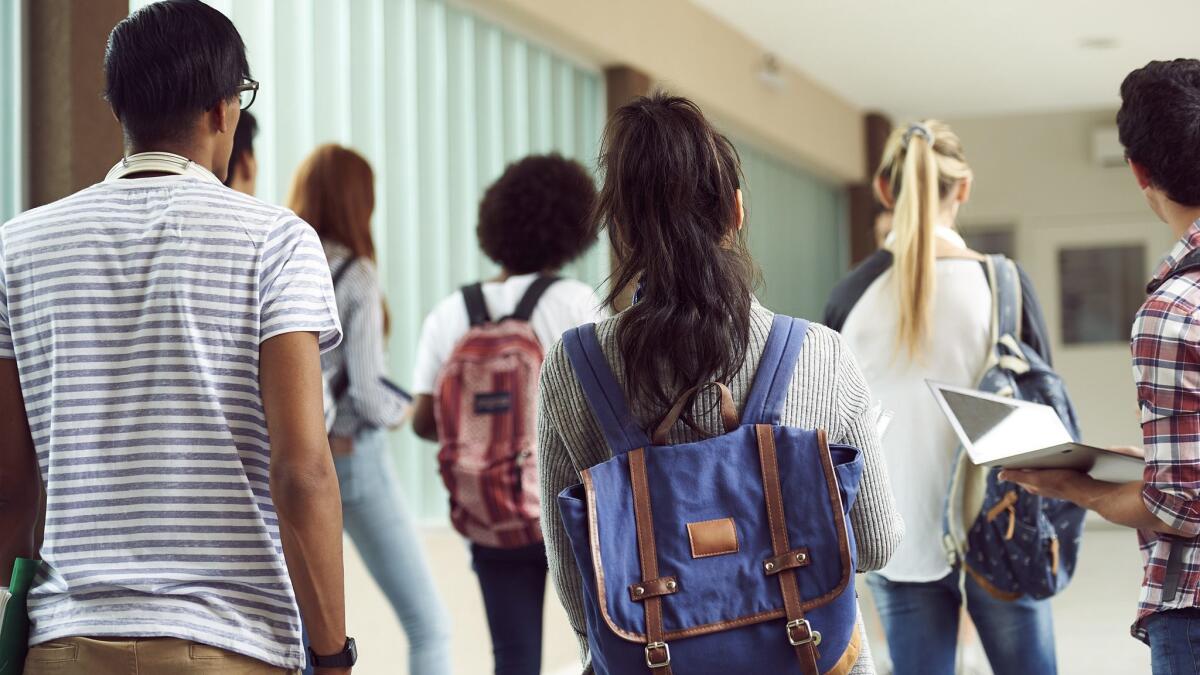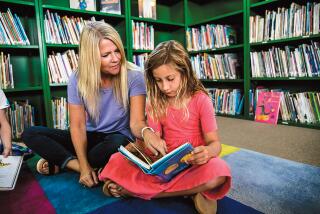Op-Ed: How to make high schools better for students

Instinctively, we all know that a huge gap exists between the best and worst high schools. But what does it take to create a truly good high school — a place where students aren’t simply fed information but can grow as thinkers and as people? This is what the two of us set out to learn when we began writing a book on how to remake the American high school.
Our research in 30 public high schools across the country found that great high schools share something essential in common: They cultivate mastery, creativity and identity. In other words, students in these schools are given regular opportunities to develop significant knowledge and skills, to use their knowledge to produce something original, and to connect their learning to who they are and who they seek to become. The presence of these qualities produces deep engagement — the thing that educators so often struggle to foster.
Unfortunately, these qualities are fairly rare in American high schools today. In most of the schools we observed — even those with reputations for being innovative — students saw little purpose or meaning in what they were doing. Some were defiant; others made sophisticated attempts to “play the game of school.” Very few, however, described their schools as places where they could thrive. National studies confirm that the bulk of high school students are bored at school daily. As one Spanish teacher told us, “I’ve got a lot of kids who would rather be in, you know, a dungeon.”
Fundamentally, the core problem is that the way American society organizes schooling does not align very well with what we know about learning.
Here’s how we organize schooling. Strict curriculum guides determine what students learn (say, graphing a line), how they should learn it (by copying what is on the board), who they should learn it from (the teacher), on what timeline (by tomorrow), and for what purpose (to pass the test/class/grade). No wonder disengagement is the norm.
Powerful learning — not only in school, but also in life — occurs when learners are trying to produce or do something consequential.
Here’s what we know about learning. Powerful learning — not only in school, but also in life — occurs when learners are trying to produce or do something consequential, when they see the purpose in what they are doing, when they have some choice about what they learn, when they are receiving regular feedback on their work, and when they are part of a community that supports them but also holds them to high standards.
Powerful learning experiences balance “liberal” virtues such as intrinsic motivation and creativity with more “conservative” virtues such as disciplined practice and feedback. Finally, powerful learning experiences honor the developmental needs of the specific learners in question. In the case of high school, that means recognizing adolescents’ needs for agency, community, and responsibility.
We encountered a number of break-the-mold classrooms and other spaces that showed how these principles can be honored in schools. In one project-based classroom, for example, students explored the question of how the world might end, with rival teams researching different apocalyptic scenarios. The project culminated in a presentation day when each team mounted evidence about the likelihood of its particular doomsday scenario. The tone of the project was at times playful, but students were also deeply invested in it and could articulate how it connected to their lives, both present and future.
Elsewhere, in a literature elective, we saw students conducting a multiweek exploration of Descartes’ assertion “I think therefore I am.” By turns, they considered and debated questions such as “Computers think, but do they exist?” and “People in vegetative states exist, but do they think?” Spending so much time exploring one set of questions in depth provoked deep intellectual engagement and tapped into adolescents’ curiosities.
We saw some of the most promising learning of all happening in extracurricular activities, where students took on positions of leadership, learned from peers, and gradually were inducted into doing the work of their fields. Encompassing activities such as newspaper, theater, athletics and debate, extracurriculars provided opportunities to do authentic work in a mode where students led the learning while adults served more as coaches than “instructors.”
In order to make these kinds of experiences more common, schools should start by slowing down. They could offer fewer subjects in longer blocks, give students more choice over what they learn, and empower students as participants in doing the work of the fields as opposed to simply receiving knowledge. In turn, teachers need powerful learning opportunities that parallel the ones we aim to create for students.
Policy could help by moving away from mile-wide, inch-deep standards and tests, by offering credit for out-of-school learning opportunities and by giving schools more flexibility to reimagine their programs of study. Finally, colleges and universities, whose demands organize much of what happens in high schools, could diversify their admission criteria, looking at portfolios of student work rather than simply at grades and test scores.
Enter the Fray: First takes on the news of the minute »
There is also an equity dimension to these questions. The schools we visited that were furthest along in making the changes described above were affluent private schools; the schools furthest from it were public schools serving high-poverty students of color. Why is it that the remedy that policymakers choose for other people’s children involves tightening the screws on the testing regime, whereas the schools (and camps and other out-of-school experiences) where many of the policymakers send their own kids are places they hope will ignite passions and build critical thinking skills?
We know what adolescents need: opportunities to do meaningful work in the company of peers, under the supervision of competent and caring adults. This is what parents want for their children and it is consistent with what science and experience tell us about learning. Why can’t we do this in our schools?
Jal Mehta (@jal_mehta) is an associate professor at the Harvard Graduate School of Education. Sarah Fine (@sarahmfine) runs a teacher preparation program at the High Tech High Graduate School of Education in San Diego. They are the authors of “In Search of Deeper Learning: The Quest to Remake the American High School.”
More to Read
A cure for the common opinion
Get thought-provoking perspectives with our weekly newsletter.
You may occasionally receive promotional content from the Los Angeles Times.






